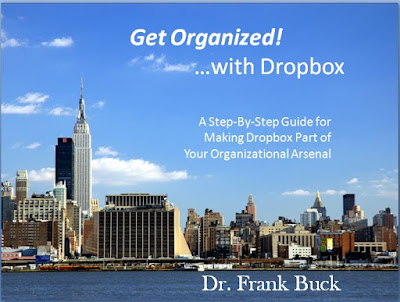Evernote is a powerful resource. It does come with a bit of a learning curve. This past July, I composed a post about Evernote and ways I was using it.
You can access that post there.

Evernote uses the concept of "notebooks" rather than folders to organize information. The new user may wonder what notebooks are needed.
First, look at your paper filing system and clean it up. Next, look at the folder system you have on your computer hard drive. For years, I have recommending setting up a folder structure on the hard drive which parallels your paper filing system. That way, documents which come to you on paper will have a place where they can be filed. Documents which come to you electronically will have a parallel place.
Let's extend that concept to Evernote. The categories which have emerged in your life for your paper filing needs and digital filing needs are going to be pretty much the same when you start working with Evernote. So, as you create notebooks and brainstorm what notebooks you may later need, let the filing systems you already have in place be your guide.
That being said, you need not worry too much initially about a complete notebook structure. As you use Evernote. Changing information from one notebook to another is as easy as choosing from a drop-down menu.
In my mind, when are just getting started with Evernote, you cold get by with two notebooks, one for new information yet to be processed, and one for information already processed:
.Inbox
This notebook is a must. You will make it your default notebook in Evernote. Anything you add to Evernote goes there unless you designate some other notebook. It's a place to trap incoming information. Our lives are busy. We need to be able to trap that idea, photo, or voice note quickly and then move on. Later, we can make decisions about where the information needs to go.
Some items of very temporary need. For example, you might take a picture of the parking spot where you left your car so that you can remember where to find the car after a trip. Once the trip is over and you have retrieved your car, the photo is of no use, and you would want to delete it. The next time you examine your Evernote inbox, you will see that photo, and that will be your trigger to delete it.
Notice the
dot before the first letter
in the word "
Inbox." The punctuation will cause this notebook to sort to the top of the list, which is where you want it. That notebook is going to be very different from every other notebook. It's like the mailbox. Everything goes there first, and is then dispersed as needed. Just like your email inbox, you will want to get the Evernote inbox empty on a regular basis.
Miscellaneous
As strange as it may seem, you will
function well with this as your only notebook aside from ".Inbox." You
examine ".Inbox" and whatever you want to keep is moved to
"Miscellaneous."
As you add other notebooks, you will
scrutinize the "Miscellaneous" notebook and shift items to them. I believe you will always have a need for
this "Miscellaneous" notebook. You will always have items which do not fit
neatly into one of the notebooks you have, so you need a catch-all for
such items. This arrangement is much better than having a large number
of notebooks with only one or two notes in each.
Other Notebooks
Listed below are some other notebooks I have and how you could use them:
Personal Information—This notebook will house airline frequent flyer numbers, hotel rewards numbers, various other account numbers, serial numbers for major purchases, etc. I keep all of this in my "Personal Information" notebook. Within it, I have notes entitled "A-C," "D-F," "G-L," etc. Within each note, the various accounts are listed alphabetically.
Checklists—If you are the principal, what are the steps involved in hiring a teacher. If you are a teacher, what are the tasks to perform at the end of each grading period? In your personal life, what would you put on a list of items to pack when going on a trip? Put these checklists in a notebook. When you need one, you can copy and paste it into your digital to-do list. If your to-do list has the capability, you can email from Evernote directly into your to-do list.
Classroom Observations—For principals, each visit to a classroom would be a note. Name the note with the teacher’s name. At the end of the year, notes from all observations are in one place.
Curriculum—Do you need a place to capture "best practice"? Do you need a place to house your list of standards? This notebook would likely have many notes, each one housing a particular teaching idea. You could use "tags" with the names of various subjects. All ideas related to math would have the "math" tag. You are allowed to have multiple tags, as some ideas may apply to more than one subject.
And for taking notes...
If you want to take notes, such as phone calls and meetings, and do it digitally, Evernote is the place. Title the notebook "
Journal." I feel that a
paper journal is still the best solution, and I use a digital "table of contents" (which I keep in Evernote) to help me locate specific information quickly. However, I know many people have a strong desire to use their tablets instead of paper.
My strategy would be that each phone call is a note, each parent conference is a note, each meeting is a note, etc. Evernote will date and time stamp each one, providing you with a record of exactly what happened when.
Allow Evernote to save each note to ".Inbox." At the end of the day, your responsibility will be to read what you have recorded and decide what you need to
do about any of it. The results of those decisions will go in your digital to-do list, using whatever software you choose. You may copy parts of what was input into Evernote, and paste it into the note section of a task. That action would provide you with the information you need when you perform that task.
Once you have read an ".Inbox" note and extracted
to-dos, that note will now becomes
reference information. From the drop-down menu, you would change the notebook to “Journal." In this notebook, you will have a chronological listing of all of your notes from phone calls, conferences, meetings, etc.
For those who already use Evernote, what suggestions do you have for a naming your notebooks?
















